Top 10 diseases in dogs and cats
Data reveals the most common diagnoses for dogs and cats during various stages of life.
What’s the most common ailment among your patients? If it’s some type of dental condition, you’re in good company. Dental calculus was one of the most common problems among dogs and cats in 2009, and teeth troubles affected pets of all ages, according to data from the Banfield Applied Research and Knowledge (BARK) Team. Excessive weight gain was another common problem. Here’s a look at the most common health conditions among the largest sample group, mature adult pets, which included nearly 700,000 dogs and cats.
The Banfield Applied Research and Knowledge (BARK) Team recently analyzed data from more than 1.7 million dogs and more than 375,000 cats, separated by age group based on the pets’ first visit date in 2009.
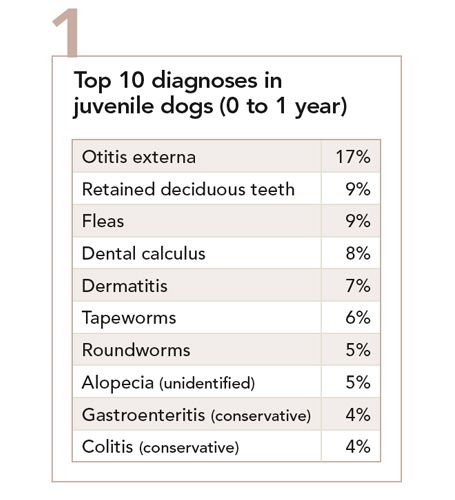
Data source: 2009 Canine and Feline Satistics by Age Group, Banfield Applied Research and Knowledge
The complete package:
Top 10 diagnoses in juvenile dogs
Top 10 diagnoses in young adult dogs
Top 10 diagnoses in mature adult dogs
Top 10 diagnoses in geriatric dogs
Top 10 diagnoses in juvenile cats
Top 10 diagnoses in young adult cats
Top 10 diagnoses in mature adult cats
Top 10 diagnoses in geriatric cats
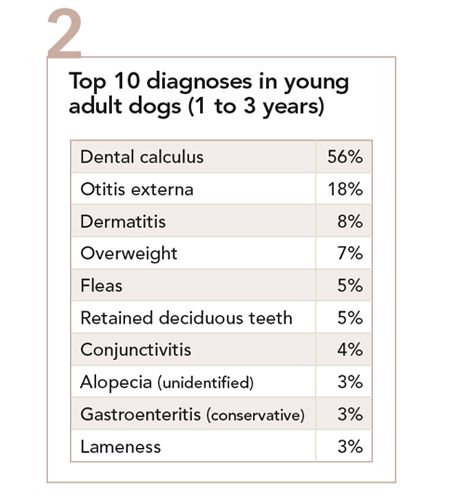
The complete package:
Top 10 diagnoses in juvenile dogs
Top 10 diagnoses in young adult dogs
Top 10 diagnoses in mature adult dogs
Top 10 diagnoses in geriatric dogs
Top 10 diagnoses in juvenile cats
Top 10 diagnoses in young adult cats
Top 10 diagnoses in mature adult cats
Top 10 diagnoses in geriatric cats
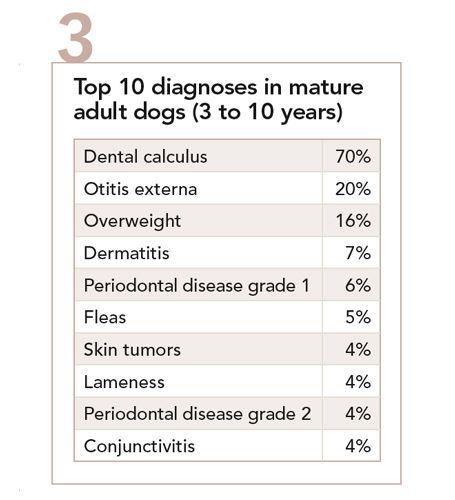
Data source: 2009 Canine and Feline Satistics by Age Group, Banfield Applied Research and Knowledge
The complete package:
Top 10 diagnoses in juvenile dogs
Top 10 diagnoses in young adult dogs
Top 10 diagnoses in mature adult dogs
Top 10 diagnoses in geriatric dogs
Top 10 diagnoses in juvenile cats
Top 10 diagnoses in young adult cats
Top 10 diagnoses in mature adult cats
Top 10 diagnoses in geriatric cats
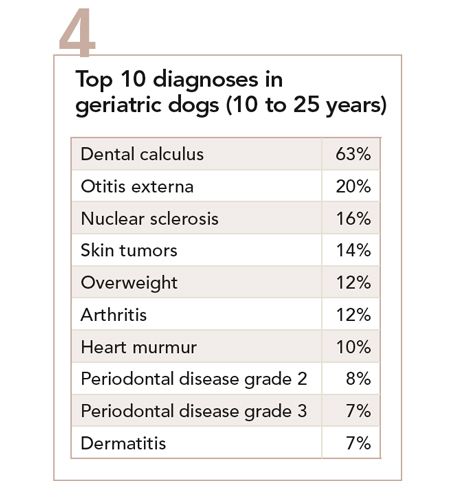
Data source: 2009 Canine and Feline Satistics by Age Group, Banfield Applied Research and Knowledge
The complete package:
Top 10 diagnoses in juvenile dogs
Top 10 diagnoses in young adult dogs
Top 10 diagnoses in mature adult dogs
Top 10 diagnoses in geriatric dogs
Top 10 diagnoses in juvenile cats
Top 10 diagnoses in young adult cats
Top 10 diagnoses in mature adult cats
Top 10 diagnoses in geriatric cats
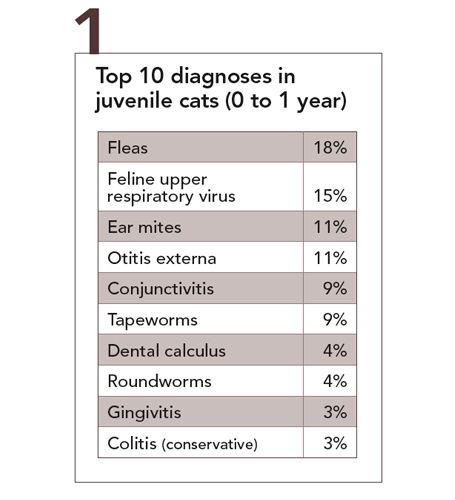
Source: 2009 Canine and Feline Satistics by Age Group, Banfield Applied Research and Knowledge
The complete package:
Top 10 diagnoses in juvenile dogs
Top 10 diagnoses in young adult dogs
Top 10 diagnoses in mature adult dogs
Top 10 diagnoses in geriatric dogs
Top 10 diagnoses in juvenile cats
Top 10 diagnoses in young adult cats
Top 10 diagnoses in mature adult cats
Top 10 diagnoses in geriatric cats

Source: 2009 Canine and Feline Satistics by Age Group, Banfield Applied Research and Knowledge
The complete package:
Top 10 diagnoses in juvenile dogs
Top 10 diagnoses in young adult dogs
Top 10 diagnoses in mature adult dogs
Top 10 diagnoses in geriatric dogs
Top 10 diagnoses in juvenile cats
Top 10 diagnoses in young adult cats
Top 10 diagnoses in mature adult cats
Top 10 diagnoses in geriatric cats
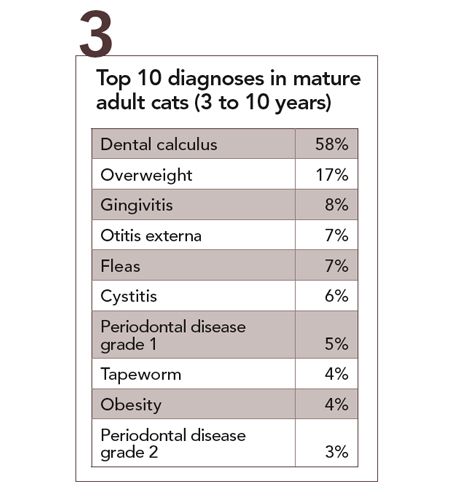
Source: 2009 Canine and Feline Satistics by Age Group, Banfield Applied Research and Knowledge
The complete package:
Top 10 diagnoses in juvenile dogs
Top 10 diagnoses in young adult dogs
Top 10 diagnoses in mature adult dogs
Top 10 diagnoses in geriatric dogs
Top 10 diagnoses in juvenile cats
Top 10 diagnoses in young adult cats
Top 10 diagnoses in mature adult cats
Top 10 diagnoses in geriatric cats
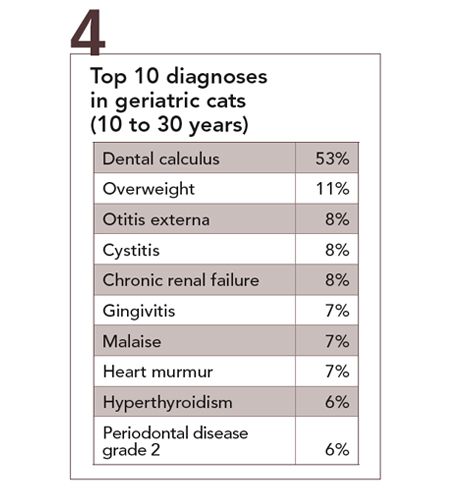
Source: 2009 Canine and Feline Satistics by Age Group, Banfield Applied Research and Knowledge
The complete package:
Top 10 diagnoses in juvenile dogs
Top 10 diagnoses in young adult dogs
Top 10 diagnoses in mature adult dogs
Top 10 diagnoses in geriatric dogs
Top 10 diagnoses in juvenile cats
Top 10 diagnoses in young adult cats
Top 10 diagnoses in mature adult cats
Top 10 diagnoses in geriatric cats
Dental calculus is the most common ailment among mature adult pets, and the risk for periodontal disease rises 20 percent each year of a pet’s life, according to data from the Banfield Applied Research and Knowledge (BARK) Team. According to Dr. Jeffrey Klausner, MS, DACVIM, Banfield’s chief medical officer, nearly four out of five dogs over the age of 3 show signs of oral disease.
These statistics beg the question: Why aren’t pet owners doing more? Published estimates say that two-thirds of pet owners believe dental care is important, but just 63 percent of those owners have ever had their pet’s teeth cleaned. And just 22 percent had ever brushed their pet’s teeth at home.So why aren’t clients taking better care of their pet’s pearly whites? It may be because they don’t take it seriously enough, Dr. Klausner says. “It’s an important disease, and I think some people minimize it sometimes, because it’s not associated with mortality,” he says. “But it reduces the quality of the pet’s life.”
The Banfield Applied Research and Knowledge (BARK) Team recently analyzed data from more than 1.7 million dogs and more than 375,000 cats, separated by age group based on the pets’ first visit date in 2009.
The complete package:
Top 10 diagnoses in juvenile dogs
Top 10 diagnoses in young adult dogs
Top 10 diagnoses in mature adult dogs
Top 10 diagnoses in geriatric dogs
Top 10 diagnoses in juvenile cats
Top 10 diagnoses in young adult cats
Top 10 diagnoses in mature adult cats
Veterinary Heroes: Patricia Kennedy Arrington, DVM, CVFP
December 1st 2024As a leader in 24-hour veterinary care and a champion for women in the field, Patricia Kennedy Arrington, DVM, CVFP, has dedicated her 50-year career to transforming veterinary medicine and inspiring future practitioners.
Read More